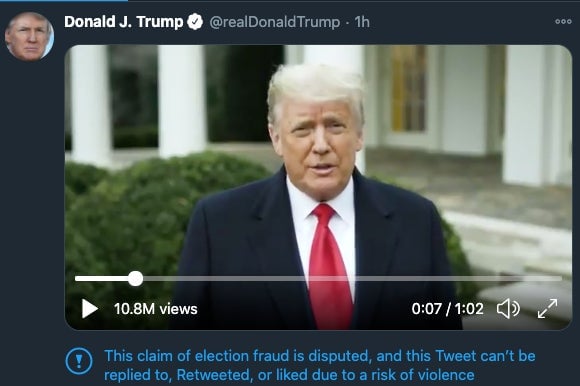Facebook’s ex-security chief says social media networks should ban Trump
As supporters of president Donald Trump stormed the US Capitol on Jan 6., Facebook’s former chief security officer Alex Stamos excoriated social media networks’ tolerance of Trump’s rhetoric. Stamos called for Twitter and Facebook to “cut him off” as the outgoing president rejected election results and provoked supporters to resist the certification of Biden’s election.


As supporters of president Donald Trump stormed the US Capitol on Jan 6., Facebook’s former chief security officer Alex Stamos excoriated social media networks’ tolerance of Trump’s rhetoric. Stamos called for Twitter and Facebook to “cut him off” as the outgoing president rejected election results and provoked supporters to resist the certification of Biden’s election.
It is Stamos’s most drastic condemnation of the platforms’ treatment of Trump since leaving Facebook in 2018, reportedly over disagreements about the handling of Russian election meddling and misinformation.
Stamos, now the director of Stanford University’s Internet Observatory, was joined on Twitter by another social media veteran: Chris Sacca, an early investor in Twitter. “You’ve got blood on your hands,” he told CEO Jack Dorsey and Facebook founder Mark Zuckerberg. “For four years you’ve rationalized this terror. Inciting violent treason is not a free speech exercise. If you work at those companies, it’s on you too. Shut it down.”
These are just among the latest calls for the social media giants to enforce their codes of conduct given Trump’s allusions to and even direct incitement of racism, harassment, and violence. For years, the networks have straddled a line between policing their content and contextualizing prominent voices such as Trump’s that break the rules, rather than remove them outright.
Those attempts appear to have run up against the US president’s own escalating rhetoric, as well as Trump supporters’ ability to organize violent gatherings on the platforms. On the afternoon of Jan. 6, Trump posted a videotaped statement, viewed more than 10.8 million times, ostensibly calling for “peace” among his supporters storming the Capitol while falsely claiming multiple times that “we had an election that was stolen from us…this was a fraudulent election.” The post was labeled as disputed content.

Stamos argues the value of allowing Trump to retain this microphone on a private platform as if it were contributing to good-faith exchange of ideas was no longer tenable. “The subversion of democratic process eliminates the basic reasons for carrying such speech (whether labeled, downranked or not),” he wrote. “When this is over, we will have to again wrestle with the legitimate problem of trying to hold multiple ideas in our heads: 1) Tech platforms are too powerful 2) Free expression is critical to democracy 3) The speech of democratic actors can be extremely dangerous.”
Later in the day, Guy Rosen, who leads Facebook’s safety and integrity efforts, said it was removing Trump’s video. “This is an emergency situation and we are taking appropriate emergency measures, including removing President Trump’s video,” he wrote on Twitter. “We removed it because on balance we believe it contributes to rather than diminishes the risk of ongoing violence.”
Twitter, too, has deleted three of the president’s tweets as of 7pm eastern time, including the video and a tweet that repeated his fraudulent election claims. It also took the step of locking Trump’s Twitter account for 12 hours after the tweets were removed; if the account does not delete the offending tweets, it will remain locked.
Removing Trump from Facebook or Twitter, of course, will not eliminate his ability to reach millions of people. Trump, along with others in the far-right conservative movement, have already begun moving to extremist havens online such as Parler and Gab. And, like all Americans, Trump will remain protected by the first amendment of the US Constitution that prohibits government infringement of public speech.
That right, however, allows private entities such as Facebook or Google to manage conduct on their own platforms. That could have profound consequences for Trump after he leaves office this month.
Politicians who lost their accounts, or see their posts restricted, may lose their ability to reach deep into the American mainstream as they have the last four years. Take figures such as Glenn Beck (formerly of Fox News) and Milo Yiannopoulos (formerly of Breitbart). Both have largely vanished from public consciousness after being dropped by their respective outlets over increasingly outlandish behavior.
For Trump’s political future, it could cripple his ability to reach out beyond a devoted fanbase. “As our team documented throughout this [election] cycle,” wrote Stamos, “the disinformation problem is almost uniquely being driven by political elites, including the President. This means that action on a minority of accounts by a handful of platforms might actually have impact.”
Of course, Trump is a singular politician. Few, like the president, can raise an astounding $495 million in the few months since mid-October—almost half of it after election day. Whatever his fate on Twitter and Facebook, those resources will give the soon-to-be-former president a microphone only money can buy.
This story has been updated to reflect Twitter’s removal of three of Donald Trump’s tweets and the locking of his account.